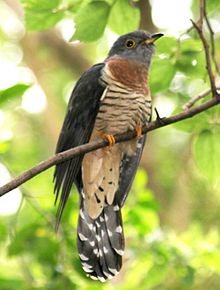Red-chested cuckoo
| Red-chested cuckoo | |
|---|---|

| |
| Red-chested cuckoo at Kibale Forest National Park, Uganda | |
| Calls recorded in Kitale, Kenya | |
| Scientific classification | |
| Domain: | Eukaryota |
| Kingdom: | Animalia |
| Phylum: | Chordata |
| Class: | Aves |
| Order: | Cuculiformes |
| Family: | Cuculidae |
| Genus: | Cuculus |
| Species: | C. solitarius
|
| Binomial name | |
| Cuculus solitarius Stephens, 1815
| |
The red-chested cuckoo (Cuculus solitarius) (or Nyamuthowathowane in the Luvenḓa (Venḓa) language), is a species of cuckoo in the family Cuculidae. It is a medium-sized bird found in Africa, south of the Sahara. In Afrikaans, it is known as "Piet-my-vrou", after its call.[2]
Description
[edit]The red-chested cuckoo is a medium-size cuckoo about 31 cm (12.2 in) in length. The male has slate-grey upper parts, pale grey throat and sides of head and dark grey tail tipped with white. The breast is rufous or cinnamon, often with barring, and the belly is creamy-white or pale buff. The female is similar but the colour of the breast is duller and with variable amounts of barring.[3]
Distribution and habitat
[edit]



It is found in Angola, Benin, Botswana, Burundi, Cameroon, Central African Republic, Chad, Republic of the Congo, Democratic Republic of the Congo, Ivory Coast, Equatorial Guinea, Eswatini, Ethiopia, Gabon, Gambia, Ghana, Guinea, Guinea-Bissau, Kenya, Lesotho, Liberia, Malawi, Mali, Mozambique, Namibia, Nigeria, Rwanda, Senegal, Sierra Leone, Somalia, South Africa, Sudan, Tanzania, Togo, Uganda, Zambia, and Zimbabwe.[1] In Southern Africa it is a common breeding migrant, found throughout the area except for the drier west. The preferred habitats for the red-chested cuckoo are woodlands. The red-chested cuckoo is normally seen by itself rather than in the company of birds of the same species.[3]
Behaviour
[edit]It is usually solitary and highly vocal and lives on forests and plantations. It eats insects including hairy caterpillars, spiders, centipedes, millipedes, slugs, snails, small vertebrates and berries.[3]
The red-chested cuckoo takes on more than a single mate (it is polygamous). The nesting habit of red-chested cuckoo is to use the nest of another bird (brood parasitism). About fifteen different species of small bird are parasitised but the most common hosts are the Cape robin-chat (Cossypha caffra), the Cape wagtail (Motacilla capensis) and the white-throated robin-chat (Cossypha humeralis).[4] The surrogate family then raise the chick. The bird lays eggs which are brown in colour and number between 20 eggs per season in different nests.[3] Like other cuckoos, the red-chested cuckoo lays its eggs in other birds’ nests, leaving the parasitized birds to care for the cuckoo chicks, which they do, believing it is their own offspring.
References
[edit]- ^ a b BirdLife International (2016). "Cuculus solitarius". IUCN Red List of Threatened Species. 2016: e.T22683862A93004360. doi:10.2305/IUCN.UK.2016-3.RLTS.T22683862A93004360.en. Retrieved 12 November 2021.
- ^ Sinclair, Ian (31 July 1995). Voëls van Suider-Afrika. Struik. ISBN 1-86825-197-7.
- ^ a b c d Erritzøe, Johannes; Mann, Clive F.; Brammer, Frederik; Fuller, Richard A. (2012). Cuckoos of the World. Bloomsbury Publishing. pp. 451–453. ISBN 978-1-4081-4267-7.
- ^ "Cuculus solitarius (Red-chested cuckoo)". Biodiversity Explorer. Izico. Retrieved 2014-06-10.
External links
[edit]- Red-chested cuckoo - Species text in The Atlas of Southern African Birds.

